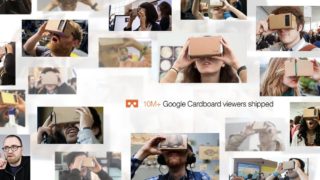Delivering compelling content in virtual and augmented reality continues to be a burgeoning motive for brands looking to build robust marketing missions.
Ever since Google allowed for mobile-driven, 360-degree videos to work its magic on YouTube, a laundry list of marketers have experimented with the immersive technology to help total hundreds of thousands of 360 videos available on a platform that boasts over one billion hours of daily video consumption around the globe—a figure that is on pace to bypass traditional TV consumption.
“YouTube has an incredibly wide reach and makes 2D, 360-degree and VR video accessible on desktop, mobile and in a headset (like Cardboard or Daydream). With the launch of YouTube VR on Daydream, we’ve seen great interest in immersive video growth from Daydream users,” Aaron Luber, head of content partnerships for Google and YouTube, told [a]listdaily. “We have been very happy with the performance of VR video content and YouTube in the first few months of Daydream following the YouTube VR launch.
During the Game Developers Conference in San Francisco last week, Google leveraged the mobile gaming side of VR by announcing titles from top developers will be joining their Daydream lineup. Daydream users are spending approximately 40 minutes per week using the devices, with video-watching being the top category of entertainment.
At Mobile World Congress in Barcelona last week, Google announced that it had shipped more than 10 million Cardboard VR viewers, and that Cardboard app downloads had exceeded over 160 million downloads—30 of those apps have over one million downloads.

Overall, however, sales of VR headsets have seemingly been sluggish, something Google is actively working on fixing to leverage their six Daydream-ready phones.
“We are making significant bets on VR and AR as the future of computing,” Luber said. “We are focusing on making this technology as accessible to as many people as possible thru mobile devices (that work with Cardboard and Daydream). We need to keep a realistic viewpoint on what the industry needs to grow—there is still a lot of work to be done across hardware, software, development and monetization, but we are dedicated to investing time and resources here for the future.”
Daydream was built based off of the lessons learned from Cardboard, and last month, Google brought virtual worlds to browsers by allowing users to begin experiencing VR on the web with Chrome.
YouTube is continuing to position the company as a viable alternative for TV advertisers looking to reach young people and cord-cutters as the lines between TV and online video continue to blur, further evidenced by the recent announcement of YouTube TV, a new $35 online cable bundle with 40 networks. They are also initiating auditing metrics with third party data collection partnerships to ease advertiser concerns, and cutting the unskippable 30-second unit.
Luber said brands have been doing an incredible job embracing their VR technology as they continue to learn and iterate.
“Brands and advertisers need to go through this learning phase as content creators to determine what works for them, their content and their audience,” Luber said. “We’ve been very impressed with the likes of The New York Times, BMW and Lowes—just to name a few. For brands looking to get started, I’d suggest experimenting with 360-degree video. The cost of production is getting less expensive, and the amount of amazing creators in the ecosystem is growing rapidly. It’s easier than ever to get started—upload video to YouTube and have huge reach and distribution.
Luber said he’s seen incredible growth in 360 and VR video over the past two years since introducing 360 formats to YouTube.
“360 and VR video is unique for brands and advertisers because it offers their audience a really immersive experience that can tie them closely to their brand and messages,” Luber said. “The cameras, tools and best practices are getting easier and more accessible. We are excited to see the continued growth in this category and we definitely think now is the time for all creators to be getting into 360/VR video as a way to reach a very engaged audience.”
Follow Manouk Akopyan on Twitter @Manouk_Akopyan

